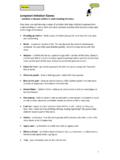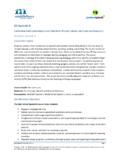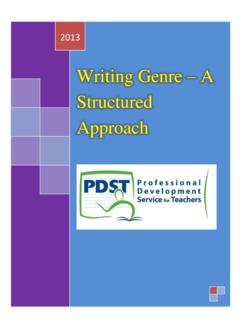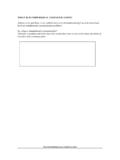Transcription of Great Myths Great Depression These and other by the facts ...
1 Mackinac Center for Public Policy | Great Myths of the Great Depression 1 GreatMyths of the Great Depression HERBERT HOOVER believed government should play no role in the economy. GOVERNMENT PROGRAMS helped lower unemployment by putting many Americans to work. FRANKLIN ROOSEVELT S New Deal saved America from the failure of free-market capitalism. This edition is a joint project of the Mackinac Center for Public Policy and the Foundation for Economic EducationThese and other Myths are dispelled by the facts in this essay by economist Lawrence W. ReedFreedom s Home Since 1946 FOUNDATION FOR ECONOMIC EDUCATION30 South Broadway, Irvington-on-Hudson, NY 10533 (914 )591 -7230 Center for Public Policy | Great Myths of the Great Depression 2 Great Myths of the Great Depression by Lawrence W.
2 Reed. Original edition printed in 1981. This edition was printed in 2008 during the 20-year anniversary of the Mackinac Center for Public Policy as a joint project of the Mackinac Center and the Foundation for Economic JaMes M. Rodney a Great friend of truth, character and libertyMackinac Center for Public Policy | Great Myths of the Great Depression 1students today are often given a skewed account of the Great Depression of 1929-1941 that condemns free-market capitalism as the cause of, and promotes government intervention as the solution to, the economic hardships of the era. In this essay based on a popular lecture, Mackinac Center for Public Policy President Lawrence W.
3 Reed debunks the conventional view and traces the central role that poor government policy played in fostering this legendary workers was out of a job at the Depression s nadir, and ugly rumors of revolt simmered for the first time since the Civil War. The terror of the Great Crash has been the failure to explain it, writes economist Alan Reynolds. Pe o p l e w e r e l e f t w i t h t h e feeling that massive economic contractions could occur at any moment, without warning, without cause. That fear has been exploited ever since as the major justification for virtually unlimited federal intervention in economic affairs. 1 Old Myths never die; they just keep showing up in economics and political science textbooks.
4 W i t h o n l y a n o c c a s i o n a l exception, it is there you will find what may be the 20th century s greatest myth: Capitalism and the free-market economy were responsible for the Great Depression , and only government intervention brought about America s economic Modern FAiry TAleAccording to this simplistic perspective, an important pillar of capitalism, the stock market, crashed and dragged America i n t o d e p r e s s i o n . P r e s i d e n t Herbert Hoover, an advocate of hands-off, or laissez-faire, economic policy, refused to use the power of government and conditions worsened as a result. It was up to Hoover s successor, Fr a n k l i n D el a n o R o o s e v el t , to ride in on the white horse of government intervention and steer the nation toward recovery.
5 The apparent lesson to be drawn is that capitalism cannot be trusted; government needs to take an active role in the economy to save us from inevitable those who propagate this version of history might just as well top off their remarks by saying, And Goldilocks found her way out of the forest, THE Great Depression devastated every part of America, even its smallest volumes have been written about the Great Depression of 1929-1941 and its impact on the lives of millions of Americans. Historians, economists and politicians have all combed the wreckage searching for the black box that will reveal the cause of the calamity. Sadly, all too many of them decide to abandon their search, finding it easier perhaps to circulate a host of false and harmful conclusions about the events of seven decades ago.
6 Cons e quently, many p e ople today continue to accept critiques of free-market capitalism that are unjustified and support government policies that are economically o w b a d w a s t h e G r e a t Depression ? Over the four years from 1929 to 1933, production at the nation s factories, mines and utilities fell by more than half. People s real disposable incomes dropped 28 percent. Stock prices collapsed to one-tenth of their pre-crash height. The number of unemployed Americans rose from million in 1929 to million in 1933. One of every Great Myths of the Great DepressionMackinac Center for Public Policy | Great Myths of the Great Depression 2 Dorothy made it from Oz back to Kansas, and little Red riding hood won the New York State Lottery.
7 The popular account of the Depression as outlined above belongs in a book of fairy tales and not in a serious discussion of economic Great , Great , Great , Great depressionTo properly understand the events of the time, it is factually appropriate to view the Great Depression as not one, but four consecutive downturns rolled into one. These four phases are:2I. Monetary Policy and the Business CycleII. The Disintegration of the World EconomyIII. The New DealIV. The Wagner ActThe first phase covers why the crash of 1929 happened in the first place; the other three show how government intervention worsened it and kept the economy in a stupor for over a decade.
8 Let s consider each one in i: THe Business cycleThe Great Depression was not the country s first Depression , though it prove d to b e the longest . Several others preceded common thread woven through all of those earlier debacles was disastrous intervention by government, often in the form of political mismanagement of the money and credit supply. None of the s e de pre ssions , however, lasted more than four years and most of them were over in two. The calamity that began in 1929 lasted at least three times longer than any of the country s previous depressions b e c a u s e t h e g o v e r n m e n t compounded its initial errors with a series of additional and harmful plAnners FAil AT MoneTAry policyA popular explanation for the stock market collapse of 1929 concerns the practice of borrowing money to buy stock.
9 Many history texts blithely assert that a frenzied speculation in shares was fed by excessive margin lending. But Marquette University economist Gene Smiley, in his 2002 book Rethinking the Great Depression , explains why this is not a fruitful observation:There was already a long history of margin lending on stock exchanges, and margin requirements the share of the purchase price paid in cash were no lower in the late twenties than in the early twenties or in previous decades. In fact, in the fall of 1928 margin requirements began to rise, and borrowers were required to pay a larger share of the purchase price of the margin lending argument doesn t hold much water.
10 Mischief with the money and credit supply, however, is another monetar y e conomists , particularly those of the Austrian School, have observed the close relationship between money supply and economic activity. When government inflates the money and credit supply, interest rates at first fall. Businesses invest this easy money in new production projects and a boom takes place in capital goods. As the boom matures , business costs rise, interest rates readjust upward, and profits are squeezed. The easy-money effects thus wear off and the monetary authorities, fearing price inflation, slow the growth of, or even contract, the money supply. In either case, the manipulation is enough to knock out the shaky supports from underneath the economic house of prominent interpretation of the Federal Reserve System s actions prior to 1929 can be found PEOPlE wHO ARGuE that the free-market economy collapsed of its own weight in the 1930s seem utterly unaware of the critical role played by the Federal Reserve System s gross mismanagement of money and Center for Public Policy | Great Myths of the Great Depression 3in America s Great Depression by economist Murray Rothbard.





